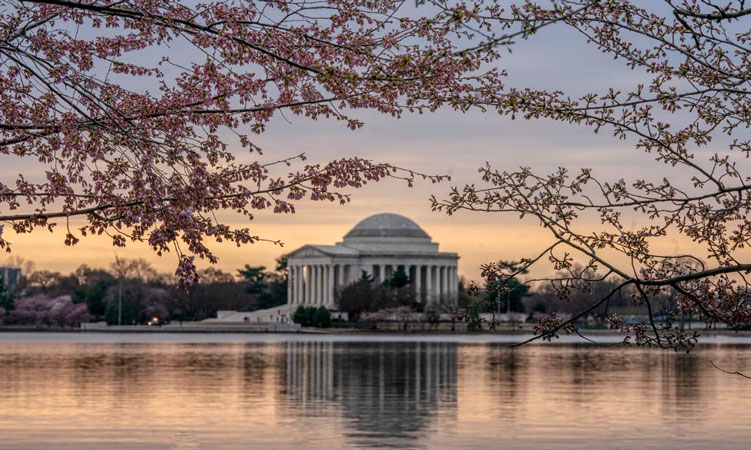When a monument turns 80, it gets a boost

The Jefferson Memorial is framed by blooming cherry blossoms along Washington’s Tidal Basin. (© J Scott Applewhite/AP)
As the Thomas Jefferson Memorial turns 80 on April 13, its caretakers are taking steps to ensure that visitors can continue to enjoy it and the beauty of the Tidal Basin in which it sits for decades to come.
A popular destination for locals and tourists alike, the Tidal Basin next to the National Mall draws large crowds each spring when its cherry blossom trees—a gift from Japan to the United States—are in full bloom. The Jefferson Memorial, dedicated in 1943 to the third US President and principal author of the Declaration of Independence, anchors the site.
But when the sea level rises, the sidewalks are often flooded. In addition, the ground under the Mall is sinking due to heavy traffic. In some places, the paths have become too narrow, forcing pedestrians onto grassy areas where tree roots are all too often trampled on.
“A sacred civic space”
Over the past 80 years, the Tidal Basin and the National Mall area have “developed into an iconic national landscape, a sacred place for citizens,” says Teresa Durkin, project manager for the Trust for the National Mall. But “this landscape is fragile and vulnerable.”
The National Park Service is taking a big step to counter rising water levels with a $5.7 million seawall repair project around the Tidal Basin. Spokesman Mike Litterst said the Park Service is trying to fix the immediate problem and manage rising sea levels “for the next 25, 50, 75 years.” Construction will start at the end of 2023.
Recognizing the larger issues, the Park Service has partnered with two organizations – the National Trust for Historic Preservation and the Trust for the National Mall – to form the Tidal Basin Ideas Lab to develop innovative, longer-term solutions.
The lab asked five landscape architecture firms for proposals to address environmental challenges, rebuild aging infrastructure, and create guidelines for implementing change.
Different visions for the area
The proposals of the five landscape architecture offices DLANDstudio, GGN, Hood Design Studio, James Corner Field Operations and Reed Hilderbrand show different approaches.
- Hood Design Studio, based in Oakland, California, recommends considering the region’s rising sea levels and rebuilding urban ecologies. “Let the water be free,” he says in his proposal. “Start living in a wetland instead of draining it.”
- New York-based James Corner Field Operations offers three options, one of which would allow visitors to observe nature’s monuments and flooding cycle from an elevated walkway.
- Seattle-based firm GGN is calling for small changes that would buy time to adjust to changing circumstances, proposing new floodplain forests that “slow floodwaters while fitting into the national capital’s aesthetic” and preserving nearby cultural amenities would.
- Reed Hilderbrand of Cambridge, Massachusetts, calls for a “disciplined” development of a vast recreation complex, including “the harmonious migration of people, plants, and animals — especially the cherry trees — to fertile soils.”
- New York’s DLANDstudio recommends creating new wetlands and green walls to accommodate rising water while protecting the cherry trees and nearby Franklin D. Roosevelt and Martin Luther King Jr. monuments by relocating them.

Lab estimates that up to $500 million in modernization could be required to keep the Tidal Basin area viable for future generations. The National Park Service will invite public feedback for suggestions and collaboration to find new ways to interpret the Jefferson Memorial and make it even more welcoming to visitors.


